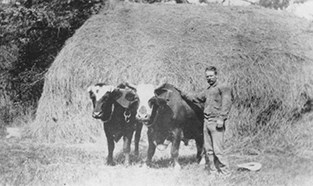The local Royal Canadian Legion’s Remembrance Day morning memorial service for the public, beginning in 1946, is one of the largest community gatherings of the year.
This continued great attendance, with 20th-century war veterans very nearly all having left us, is something to reflect on. It is also an opportunity to share important stories and examine how we are doing at remembering them.
Squamish has an especially attractive War Memorial Cenotaph plaza in Stan Clarke Park, completed five years ago. It is surrounded by 23 birch trees commemorating the men of the Legion’s Squamish Valley Honour Roll – service men “who do not answer,” who did not return from the overseas wars.
Squamish Valley Honour Roll’s George Paddy
The War Memorial Cenotaph happens to be located on what was once the farm of George Paddy – the first name on our Honour Roll.
George Paddy, one of the Squamish townsite’s original settlers, had farmed here for 20 years before signing up with the 1st Canadian Pioneers engineering/ construction battalion, which set off for Europe from Montreal in May of 1915.
Private Paddy fell during the battle of Mount Sorrel in June of 1916. He is commemorated on the Menin Gate Memorial in the West Flanders town of Ypres. The memorial now bears the names of more than 54,000 Commonwealth service men who died in the Ypres Salient and whose graves are not known.
Each night at 8 p.m. the traffic is stopped at the Menin Gate while local fire brigade members sound the Last Post in the roadway under the memorial’s arches.
The name of another Squamish Valley Honour Roll member, Donald McDonald of Brackendale, is inscribed on the Vimy Memorial along with those of 11,000 Canadian servicemen who died in France during the First World War and have no known grave.
Local League
Madeley Lake in the Callaghan is named after Lt. W. Arthur Madeley, a PGE railway engineer at Squamish and a casualty of the World War Two Italian campaign. The J.A. Quick Memorial Forest in the Cheekye Fan honours the first from Squamish to die in WWII. Paul Ridge is named after Great War veteran and long-serving local doctor and Garibaldi Park commissioner, N.J. Paul, who collapsed and died here in 1942 while rushing to put out a bonfire after a blackout signal had sounded.
Squamish itself was profoundly affected by the First World War. One might say the failed realization of the railway terminus hub city vision for “Newport” was a casualty of that war. The development visions for Squamish and its railway were delayed for over four decades due to overseas wars.
Preserving our history
Much has been done by locals to preserve the stories of our community’s wartime experience, especially as war service veterans among us have become fewer and fewer in number.
The Squamish Public Library and Howe Sound Secondary students of the 1980s worked diligently in time to record and preserve the memories of a generation of local seniors whose experiences reached back to World War Two.
Ken Ward has recently been acknowledged by Legion Branch 277 for his painstaking efforts to recover the stories of the Squamish Valley Honour Roll members.
Donna Billy and the late Diana Billy went to work to finally properly document those who went to war among the Squamish Nation community.
Mike Wallace has chronicled the last journey of RCAF Stranraer 946, which crashed on Mount Baldwin just southeast of Squamish on Nov. 4, 1941, with five servicemen onboard.
And many will recall the exhibit hosted at Brennan Park three years ago about the Sikh community’s contributions to the Allied cause during both the First and Second World Wars.




